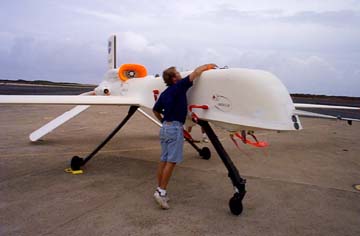


Storm front
cuts short research
craft’s flightThe global warning hunter turns
By Anthony Sommer
back to Kauai, fearing humidity and
the temperature could cause ice
to form on its wings
Star-BulletinBARKING SANDS, Kauai -- After days of watching the bright blue skies over west Kauai hoping for a cloud or two to measure, NASA sent its ALTUS II global warming research plane aloft yesterday morning as the skies turned gray.
Two hours later,the unmanned plane was back landing on the main runway at the Navy's Pacific Missile Range Facility. The reason: Too many clouds -- a storm front had moved in over the Garden Island.
Controllers began to worry when the weather forecasters warned of possible thunderstorms. Then, as ALTUS climbed through 14,000 in heavy clouds, instruments aboard the aircraft indicated the combined temperature and humidity were ripe for icing on the wings and ALTUS was steered back to Kauai.
It was the first aborted mission in seven flights, five with the science equipment aboard. Will Bolton, project manager for Sandia National Laboratories said the score includes three "outstanding" missions, two measuring cirrus clouds and one measuring clear skies.
Steve Wegener, NASA science and sensors supervisor, agreed, calling the series "highly successful" even if the final number of flights ends up being fewer than expected.
Flight schedules were delayed when a cold front stalled west of Hawaii, causing the warm, stagnant weather over the state, a typical springtime pattern. Then the front moved over Kauai yesterday, surprising weather forecasters.
The flights over the Navy's missile range are part of a lengthy effort to gather data on the effect of clouds on global warming. The information is needed for accurate computer forecasts.
"Essentially, we're trying to determine the Earth's insulation budget -- how much solar energy the earth is receiving from the sun, how much of it is being emitted back into space and how much is retained," said David Young of NASA's Langley Research Center in Hampton, Va.
Young is involved in an experiment scheduled for next week in which data from sensors in the ALTUS aircraft will be compared with readings from similar instruments in a satellite that will pass over Kauai while ALTUS is flying.
The test flights are scheduled to conclude Wednesday.